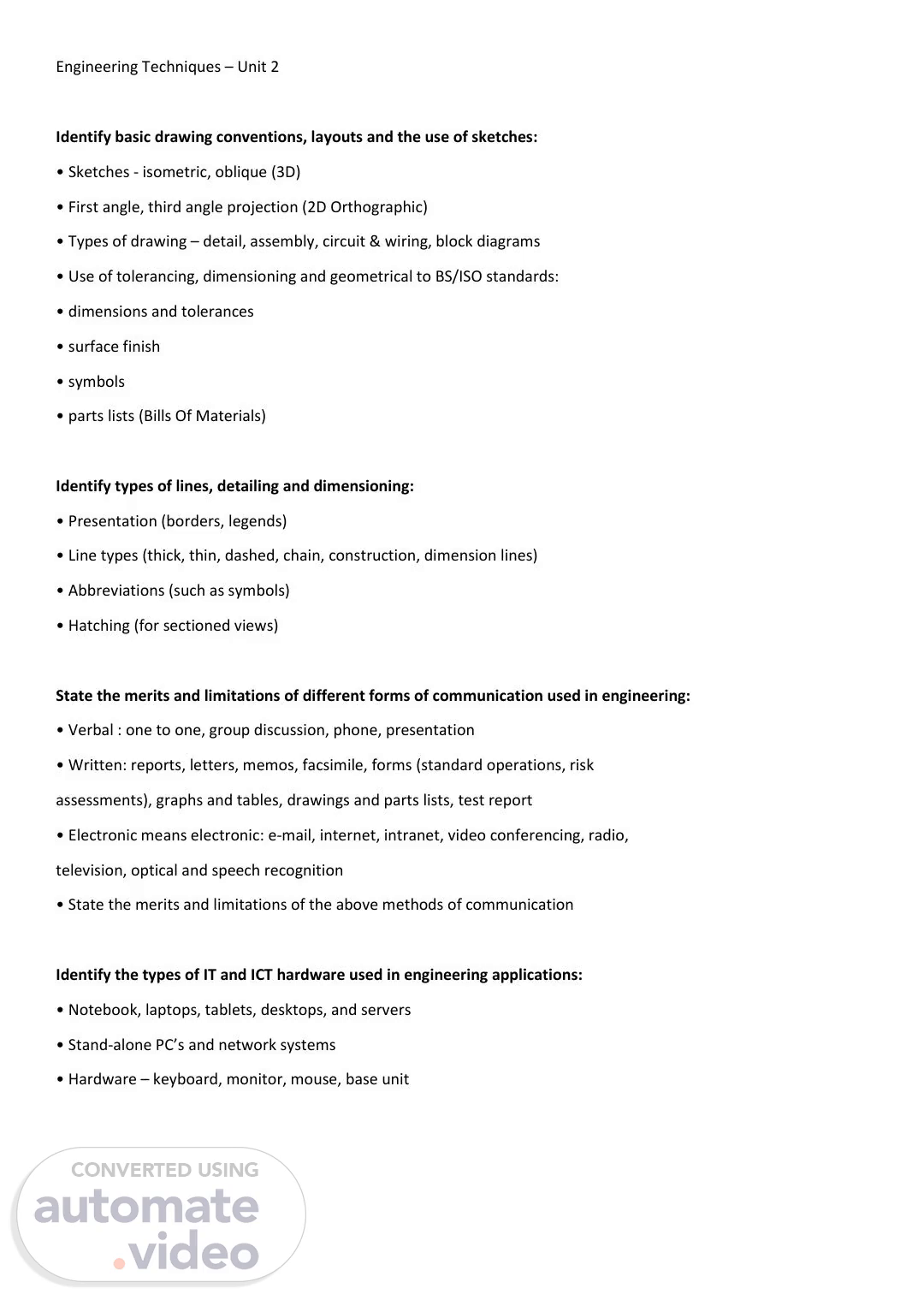Scene 1 (0s)
Engineering Techniques – Unit 2 Identify basic drawing conventions, layouts and the use of sketches: • Sketches - isometric, oblique (3D) • First angle, third angle projection (2D Orthographic) • Types of drawing – detail, assembly, circuit & wiring, block diagrams • Use of tolerancing, dimensioning and geometrical to BS/ISO standards: • dimensions and tolerances • surface finish • symbols • parts lists (Bills Of Materials) Identify types of lines, detailing and dimensioning: • Presentation (borders, legends) • Line types (thick, thin, dashed, chain, construction, dimension lines) • Abbreviations (such as symbols) • Hatching (for sectioned views) State the merits and limitations of different forms of communication used in engineering: • Verbal : one to one, group discussion, phone, presentation • Written: reports, letters, memos, facsimile, forms (standard operations, risk assessments), graphs and tables, drawings and parts lists, test report • Electronic means electronic: e-mail, internet, intranet, video conferencing, radio, television, optical and speech recognition • State the merits and limitations of the above methods of communication Identify the types of IT and ICT hardware used in engineering applications: • Notebook, laptops, tablets, desktops, and servers • Stand-alone PC’s and network systems • Hardware – keyboard, monitor, mouse, base unit.
Scene 2 (49s)
Identify the types of IT and ICT operating systems used in engineering applications: • Windows • Apple Mac OS • Incompatibility of different systems • Problems associated with integration Identify the application of standard software packages: • Word processing • Spreadsheets • Databases • Presentation packages Identify the use IT/ICT as an information source: • Intranet • Internet • CD ROM • Electronic journals, CANVAS Identify the use and application of software packages within engineering.:CAD • CAM • CNC • Simulation packages • electrical/electronic circuits • plant/process systems Identify work and tool holding methods: • Work holding methods applied to lathes, drills, milling, abrasive wheel and punching machines • Work holding equipment – vices, magnetic vices, clamps, jigs and fixtures • Tool holding methods, collets, chucks and sleeves • Applications and limitation of the above Identify the principles of engineering cutting tools: • Difference between chip and non chip forming cutting.
Scene 3 (1m 25s)
• Rake angles, clearance angles and wedge angles • Types of cutting tools, hand and machine operated equipment • Applications and limitation of the above Identify the different types and applications of engineering drill bits: • Stub and jobber drills – straight shank • Morse taper shank drills • Basic drill geometry- point angle and flute types • Drilling machine types-pistol, bench, pedestal and radial • Applications and limitation of the above Identify the basic screw thread forms: • Metric, fine, coarse, special pitch • Imperial – BSW/BSF, UNF/UNC, BSP • Specials – ACME, buttress, square Identify the basic methods of work assembly: • Thermal - welding, soldering, brazing and spot welding • Adhesives • Mechanical – bolts, screws and rivets Identify basic fault finding techniques to simple problems: • Problem solving procedures • Input to output • Half split Identify the sources of information used in engineering to support marking out activities: • Engineering drawings, Circuit diagrams, Sketches, Work instructions and Computer Software Identify the range and use of measuring and marking out equipment available: • Rules (metric and imperial) • Tapes • Scribers.
Scene 4 (2m 9s)
• Scribing blocks • Squares • Dial test indicators • Internal/external calipers • Trammels • Protractors • Micrometer instruments (metric and imperial) • Vernier instruments (metric and imperial) • Digital multi-meters (current, voltage and resistance) • Care and use of equipment • Equipment for supporting work pieces whilst measuring or marking out: • Marking out tables and plates • Angle plates • Parallel strips • Vee blocks • Jack screws • Clamps Identify methods of surface preparation before marking out: • Cleaning and preparing surfaces (mechanical and chemical) • Squareness and de-burring of edges • Application of marking out mediums • Preparation of fibre board for printed circuit boards Identify measuring and marking out techniques: • Using templates • Using and marking datum’s • Making out hole centres, centrelines, angular and radial profiles • Design and construction of a printed circuit board (PCB) Identify errors that can occur when measuring and marking out: • Parallax error (not reading the dimension on say a linear scale properly) • Accumulative error (linear and angular) • Errors due to carelessness.
